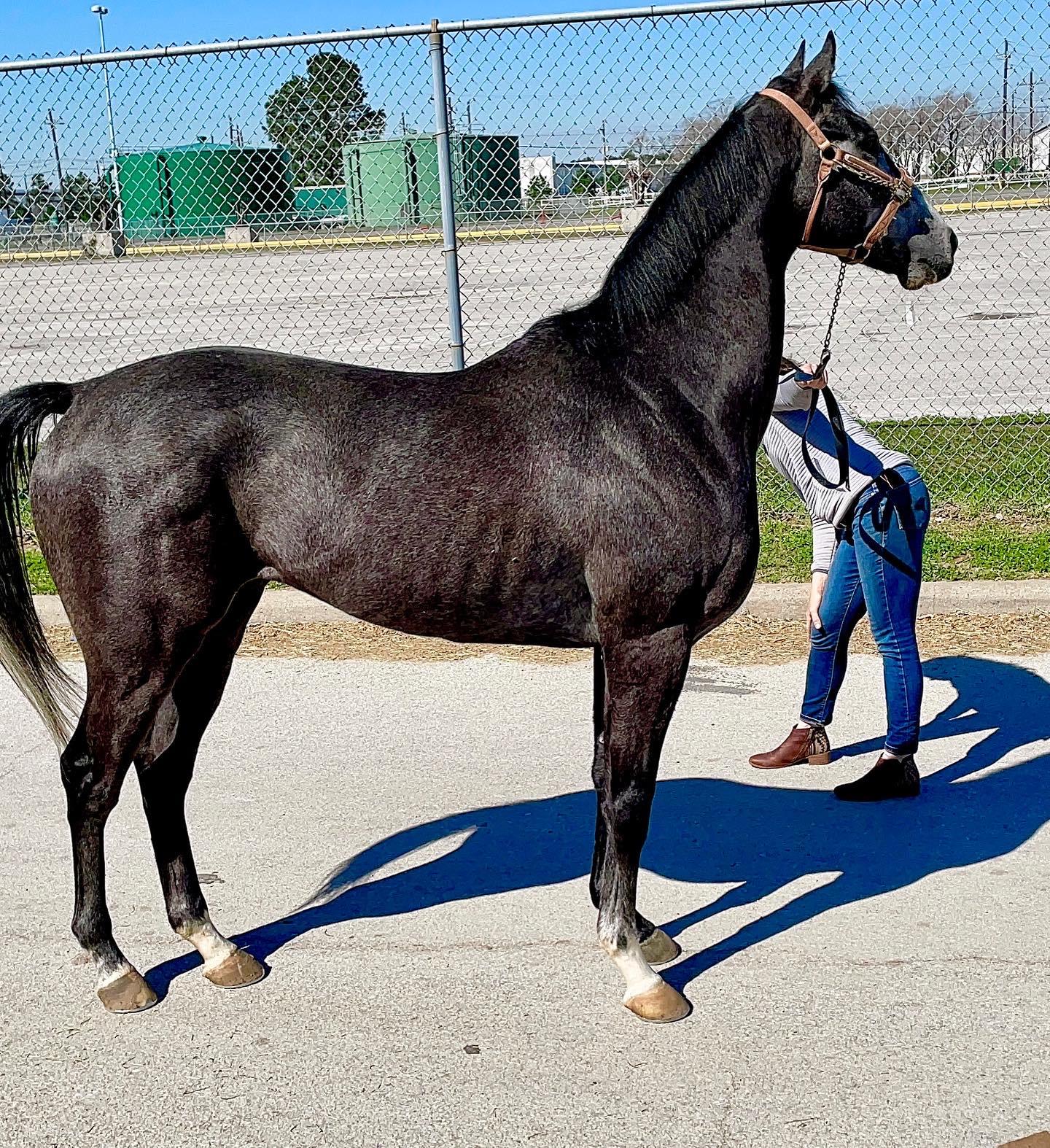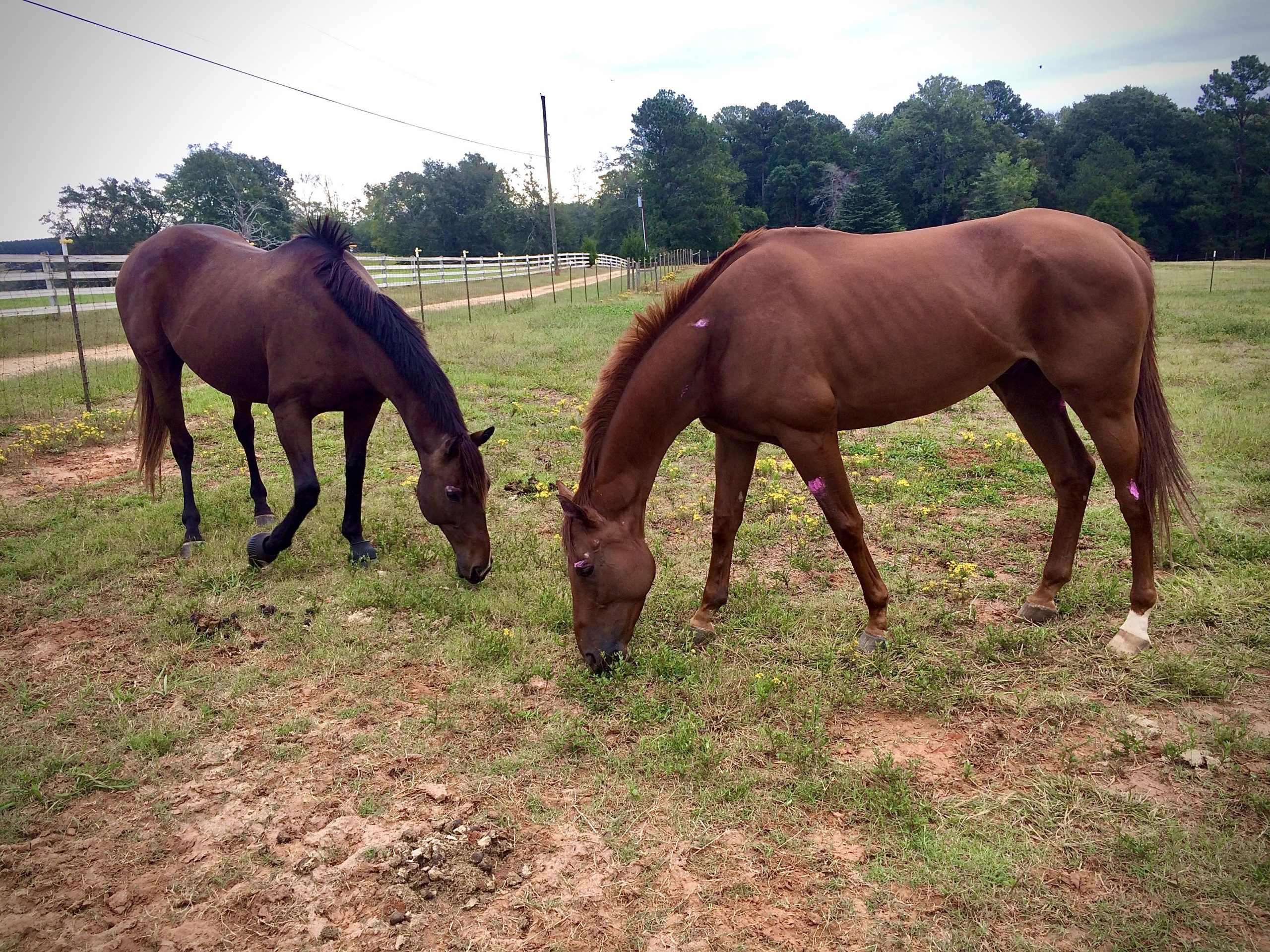
Thoroughbred Logic, Presented by OTTB United: The Post-Track Body Crash
“Transitioning [Thoroughbreds] from track to farm can be finicky business. But getting it right is essential, because folks, that post-track crash is a real thing.”
Welcome to the next installment of Thoroughbred Logic. In this weekly series, Anthropologist and trainer Aubrey Graham, of Kivu Sport Horses, offers insight and training experience when it comes to working with Thoroughbreds (although much will apply to all breeds). This week ride along as Aubrey discusses the post-track body crash and how to address it.
Each time a new Thoroughbred arrives here at Kivu, my friends/students who help with the barn have learned to ask about their proclivities and needs before starting their shift. For the most part, they no longer get wide-eyed at the long list of (verbal — because I’m not organized) instructions that might include all sorts of directions, hyper-specifics, and extras.
For instance, last week, two recently retired racehorses horses needed to have the grain poured to one side of their pan and their soaked beet pulp and alfalfa cubes to the other. Another was eating in a hanging bucket because food on the ground did not, apparently, register as food. A fourth needed their alfalfa pile tossed in a particular patch of ground in their turnout or they would not bother to consume it. Picky — all of them picky. Now add compounded omeprozol paste to the ulcer-y ones, careful turnout instructions, and blanketing requirements that break all of the “regular Thoroughbred” rules in the barn.

For days, Quality Step would not move from this patch of earth in his turnout. Getting him to eat his hay meant putting it there, exactly right there. Photo by author.
In other words, transitioning them from track to farm can be finicky business. But getting it right is essential, because folks, that post-track crash is a real thing. Often, making sure they get the nutrition, the treatments and the time they need can stem the unraveling. Sometimes though, even with the best care, these horses have a whole bunch of shedding to do — they may shed their muscle, their fat, their hair and their apparent soundness.
And from that low, we have to build them back up — with proper feed, careful turnout, good nutrition, dewormer, and gut drugs, and by treating their feet and teeth and bodies with quality farrier, dental and chiropractic work, other body work, and careful workouts (or none at all for a while). And in that state of “hide them behind the barn” they have to let down and learn to be a horse, not just a racehorse. There is usually a light at the end of the tunnel, but man, the process of reaching that bright spot can be long and complicated.

Snaps (Mr. K. W.) is in the process of transitioning from track fit to sport horse fit. Photo by Kelly Robison.
Sometimes, we’re lucky, and the track trainers and owners have done so well by their horses that there is no crash, just a somewhat simple transition from former job to new job. Pretty much all of the horses I get from Winchester Place Thoroughbreds are on the “simple, no crash” side of the spectrum. They have had turnout. They have at points weathered Kentucky winters with their shoes pulled and no blankets. And between the track and when I pick them up, they have been kicked back out with a herd to hang out and horse (yes “to horse” is apparently a verb now).

Winchester Place Thoroughbred yearlings. The older horses winter in similar herds. Photo by Lauren Schuster.
While coming in from a different race stable, Amelia’s Map, my new 2019 filly, arrived equally ready to transition to a sport horse life. I had to wait to get the rig up to KY to get her after the Makeover, and in the meantime, her race stable turned her out daily in the paddocks at the Thoroughbred Training Center in Lexington. She might have come to me directly from a race training facility and last raced in September, but her transition from there to here, from track to sport, has been straightforward. Sure, like all of them, she needs to rebuild her muscling from that akin to a greyhound to that of a Labrador and put on the associated fat that goes with not running for a living, but the process is looking like an easy one.
And then there are those who are not. As luck would have it, my first directly off-track Thoroughbred, Forrest (JC Don’t Noc It) was hell to get right (and I was working with extremely limited information on how to do this and at a boarding barn where Thoroughbreds were far from the norm). I struggled with what to feed him, with getting him to finish his meals, had no idea about ulcer meds, probably didn’t deworm him until it was the usual barn rotation to do so, and then waited and did ground work with him for months until his back let down enough for me to get on. I had the wherewithal to call out a random chiropractor for his SI joint and his stifle, but that’s all they addressed in a 10 minute visit and I was none-the-wiser to have expected more.
Forrest was body sore and track tight — his muscles knotted up and slow to relax. At the time, the best my then-vet (who had little to zero experience with recent OTTBs) was able to recommend was a set of expensive Chinese herbs. I wallowed in the mire of having bought a horse and yet having nothing to ride. We did ground work and more groundwork. But I’ll tell you what — the silver lining is all that ground work has made me that horse’s best friend (as frustratingly annoying as that can be at points). And the voice control from months of exercises on foot has saved my ass plenty in the saddle.
It took almost a year for me to figure Forrest out. I was shocked at how much weight he piled on after putting him on two weeks of GastroGuard for travel to the 2018 Retired Racehorse Project Thoroughbred Makeover. How little I knew. Now, years later, he’s a happy, annoying-as-ever chonk who thinks he runs the place. Through him, though, I learned a ton — and that wallowing around, not entirely sure what to do as he crashed is what many years later, inspired these articles.
Last week I wrote about how these horses inspire community. A take away from this week is that they also demand it — or at least demand a high quality, intelligent team. Now that I have an outstandingly good farrier, chiropractor, vet, and dentist as well as a solid nutrition plan, the crashes, when they happen, are a lot less worrisome. They become simple, “OK, what does this one need to get right?”

These horses inspire community AND take a team. Here my awesome farriers (Patrick Roth and Russell Hudson) and Chiro (Holly Breaux) put in a solid Monday worth of work. Featuring Greta (the one non-TB in the barn, left), Louis (Unbridled Bayou, center) and Forrest (right). Photo by author.
Tuck (Louisiana Bling) is a hell of a fairy tale story on this topic. I purchased him on a whim while at a wedding in Texas and had him shipped back to Georgia the next week. The angles of his hind feet were awful to say the least. But I was cocky, knew I had a damn good team to fix all the ills, and so I went with it. It was an educate gamble, but I’ll always bet on these horses.

Turns out that the photo that we have of Tuck from the track has me looking skeptically at his hind angles. Photo by Shane Drake.
As his body shed whatever he had been on at the track, he went from passably sound to not-even-close. His coat went dull and his back was sensitive to the lightest touch. He was tighter than Forrest had been — sore from a life of negative angles behind. Over the next six months we treated the tightness with Chiro and muscle relaxers, fixed his angles, trained him to ride over his back, and got him on all the best there is to offer nutritionally. It worked. He galloped on through that bright spot and found a new home with the absolutely perfect junior rider (and her knowledgable trainer) when he came to the RRP Makeover as a sale horse.
Sure, not all off-track crashes turn into these fairy tales. Not all go on to “no-limitations” careers. That said, from my sample set, most can find their way out of the tunnel with the help of a seriously good team. And now I’m off to feed — and to make sure that the four new-ish post-track Thoroughbreds here get everything they need to build up and transition without bottoming out. From the looks of it, all four are on upwards trajectories. And there starts the rewarding process of watching them blossom into the athletic, shiny, fat, goofy horses whose futures keep them riding in that light.
Thoroughbred Logic is proud to be supported by OTTB United, the premier virtual marketplace for retired racehorses built by equestrians, for equestrians. The OTTB United app unites organizations, buyers, sellers, and trainers in one interface. Download the app and give it a whirl by clicking/tapping the banner below!









